|
Report
from
Europe
Diversification in Europe*s wood product imports
There is a tendency when analysing markets for tropical
wood in Europe to focus heavily on demand for the main
primary wood products 每tropical hardwood logs, sawn,
veneers and plywood.
However globalisation trends, particularly the strong
growth of China as a wood processing hub, combined with
efforts by tropical producing countries to move up the
value chain, has meant that these products have become
relatively less important in the European market.
Tropical and other developing countries are supplying a
very wide range of secondary and tertiary processed
products into the European market.
At the same time, European subsidies to promote
renewable energy sources 每 which have contributed to
shortages and rising prices for wood fibre supplied to both
the European energy and wood panels sectors - is now
driving a trend towards rising imports of wood chips and
other forms of biomass from developing countries.
An analysis of Eurostat data indicates that last year out of
a total of 26.6 million cu.m (Roundwood Equivalent 每
RWE) of wood products imported into EU from
developing countries, 10.8 million cu.m (41%) comprised
primary processed products, 11.5 million cu.m (43%)
comprised secondary and tertiary products, and 4.3 million
cu.m (16%) comprised wood chips and other biomass.
UK heavily dependant on imports of plywood and
furniture from China
Chart 1 shows that of all European countries, the UK was
by far the largest importer of wood products from
developing countries, importing 5.2 million cu.m (RWE)
in 2010, followed by Germany (3.6 million cu.m), France
(2.9 million cu.m), Netherlands (2.6 million cu.m), and
Spain (2.5 million cu.m). The high volume of imports into
the UK is largely explained by dependence on wood
furniture and plywood imports from China.
Chart 1 also reveals that very large volumes of biomass
are now being imported from developing countries by
Spain and Portugal, with smaller volumes destined for
Germany, Italy and Belgium.
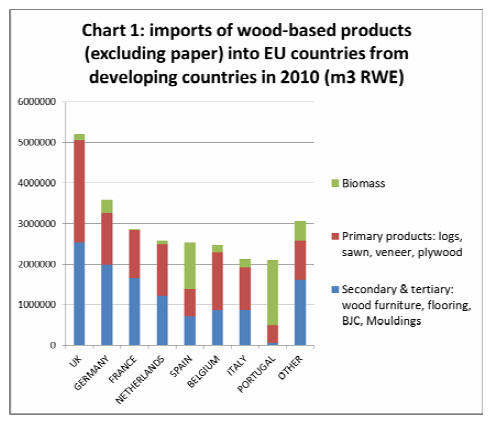
Over recent years China has emerged as a huge supplier of
a wide range of secondary and tertiary processed wood
products to the EU. Of the 9.3 million cu.m (RWE) of
wood products supplied to the EU from China in 2010,
around 6.7 million cu.m comprised further processed
products 每 mainly wood furniture and flooring (Chart 2).
Unfortunately, trade data is insufficiently detailed to allow
differentiation between further-processed products derived
respectively from tropical hardwoods and other wood
types.
The majority of wood volume sourced from China is likely
to be made up of softwood and derived products (such as
composite panels) and temperate hardwoods (notably
Chinese poplar and Russian birch). But the sheer scale of
trade suggests that significant volumes of tropical
hardwood may also be involved.

Range of wood products imported from developing
countries expanding
The range of products imported into the EU from
developing countries is also expanding.
Chart 3 highlights that secondary and tertiary products
such as furniture, flooring and mouldings, now make up a
very significant proportion of European wood product
17 ITTO TTM Report 16:17 1 每 15 September 2011
imports from Vietnam (99%), Indonesia (72%), Malaysia
(40%), and Brazil (27%).
Uruguay, Argentina and Chile are particularly important
sources of biomass into the EU. However primary wood
products - particularly sawn lumber - continue to dominate
European imports from the key African supply countries
(Cameroon, Gabon and the Ivory Coast).
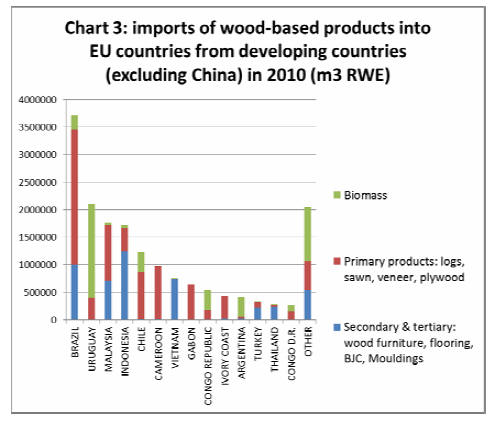
Recent trends in European imports of secondary and
tertiary wood products from developing countries are
shown in Charts 4 and 5. The credit crunch led to a
significant downturn in European imports of these
products during 2008 and 2009, but there was a return to
import growth last year.
Chart 4 indicates that imports of wood furniture, flooring
and mouldings all rebounded last year. Chart 5 shows that
China accounted for much of the increase in EU imports
of these products between 2009 and 2010. Imports of
secondary and tertiary wood products from other leading
supply countries, including Indonesia, Brazil, Vietnam,
and Malaysia, were stable between 2009 and 2010.

The growing share of finished and semi-finished wood
products from China and other developing countries in the
European market raises obvious questions over likely
long-term impact on overall levels of consumption of the
primary products of tropical hardwoods in Europe.
It also has important implications for policy measures such
as the FLEGT VPA process and the European Timber
Regulation, which will increasingly have to accommodate
legality verification procedures in more complex global
supply chains for value-added products.
This analysis highlights both the critical importance of
engagement with suppliers in China to ensure effective
implementation of these policy measures, and also the
importance of ensuring that the legality and sustainability
of biomass supply to the energy sector is subject to the
same level of scrutiny as the timber sector.
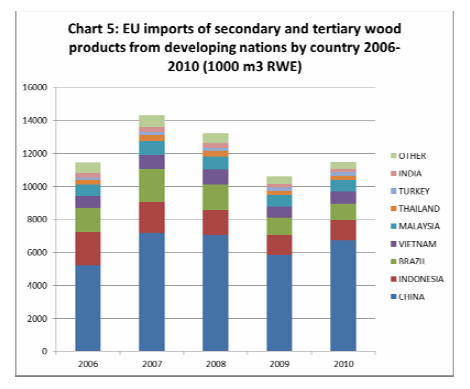
European corporations report second quarter gains in
tropical hardwood business
The latest financial reports from Rougier and DLH, two of
Europe's leading tropical hardwood corporations, indicate
continuing gains in trade during the second quarter of the
year.
Rougier announced €74.1 million in revenues for the first
half of 2011, up 9.3% in relation to last year. Building on
quarterly gains made in the first quarter of 2011, business
remained strong over the second quarter, with revenues
coming in at €39.6 million, 5.9% higher than the second
quarter of 2010.
The Rougier Africa International division recorded €55.6
million in half-year revenues, up 10.8% compared with the
first half of 2010. The second quarter of 2011 showed a
strong rate of growth(+7.9%) confirming positive trends in
demand and sales prices in both the main Western
countries, particularly Northern Europe, and certain
emerging countries.
Rougier noted that their commercial performance has been
accompanied by the development of certified sales, which
accounted for around 33% of log equivalent volumes for
Rougier Africa International's timber production over the
first half of 2011. Rougier Africa International's revenue
growth is based on the good level of activities in
Cameroon and Congo, with business in Gabon partially
affected by shipping delays at Libreville Port.
Rougier's France Import-Distribution segment recorded
€23.1 million in revenues, an increase of 8.0% in relation
to the first half of 2010. During the second quarter of
2011, sales remained at a sustained level, even if the
18 ITTO TTM Report 16:17 1 每 15 September 2011
period is compared with a high benchmark figure for
2010.
Driven by on-going adaptations to the product ranges, the
business has benefited from an improvement on the
French construction market, as well as the particularly
dynamic renovation market.
Rougier reports a continuing shift away from logs towards
more value-added in their product mix. Processed products
represented 75.8% of sales for the first half of 2011.
Growing demand for sawn timber in Asia and certified
sawn timber in mature markets allowed Rougier to
consolidate the increase in sales prices for the primary
African hardwood species compared with the first half of
2010.
However plywood and veneer sales were down 11.9% in
the first half of 2011 compared with the same period of
2010. This change primarily reflects longer shipping and
delivery times from Gabon.
Overall, Rougier comment that "tropical woods from the
Congo Basin significantly improved their competitiveness
on the world markets during the first half of 2011. Boosted
by the development of certification, Rougier's business has
benefited from growing demand on Northern European
and North American markets, which are sensitive to
environmental issues. Growth is also being encouraged by
the highly dynamic development seen in certain emerging
markets, particularly in Asia (China, India, Vietnam, etc.),
where revenue growth (19.9%) reflects the increase in
primary-processed product sales".
DLH's financial report for the first six months of 2011 is
similarly upbeat, noting that the "results show both
absolute and relative improvements to largely all our
financial ratios despite an unchanged turnover level on
the year".
In the second quarter of 2011, DLH recorded a net
turnover of DKK 849 million against DKK 895 million for
the same period last year. DLH note that lower sales in the
second quarter were expected because Easter, which
traditionally means lower activity levels, fell in April this
year.
Total turnover for the first half of the year was DKK 1,630
million which is on a par with last year. However, the
Group*s overall profitability improved over the half-year.
Earnings before interest and tax were DKK 42 million
against DKK 39 million last year.
DLH turnover growth was particularly strong in the
Nordic countries, up 7.6% in the first half of 2011
compared to the equivalent period in 2010. Turnover and
earnings in Western Europe (Netherlands, Belgium, and
France) and in Poland for the second quarter were
consistent with last year.
DLH is currently implementing a strategy to strengthen its
long term financial position and focusing on core business
areas.
The strategy includes amalgamation of a number of
inventory and sales functions in Scandinavia and the
expansion of DLH*s Asian activities in Hong Kong.
Despite greater economic uncertainty in the second half of
2011, DLH said it expected its initial forecasts for a
turnover of DKK 3.3 billion and an EBIT of around DKK
60 million in 2011 to be achieved.
Timber Expo - UK*s first dedicated timber industry show
The inaugural Timber Expo designed to bring the UK's
timber trade and industry together for the first time under
one roof will take place at the Ricoh Arena in Coventry on
the 27 and 28 September 2011.
Timber Expo aims to reveal the widest and most
comprehensive display of applications for timber within
the built environment. It will be the UK's only dedicated
event for the timber industry.
Timber Expo is designed by the timber industry and
delivered by the timber industry. It will give everyone
involved an opportunity to see and hear about the strengths
of timber and understand how it can deliver an effective,
more attractive and sustainable built environment.
TRADA*s flagship conference &In Touch with Timber*
will run across both days of Timber Expo and will inform
about the latest developments across key industry areas.
The 2011 sessions will feature several high-calibre
speakers discussing why timber is one of the most
exciting, flexible and sustainable building materials
available.
The Expo also features a series of Timber Talks on
responsible timber sourcing and certification, engineering
with timber, low carbon timber solutions and solid wood
solutions.
Of particular relevance to the hardwood sector are
presentations to be made by Rupert Oliver on Life Cycle
Assessment in the hardwood industry and by Dave
Smedley on the first hardwood glulam structure in
Malaysia.
More details at
http://www.timber-expo.co.uk/
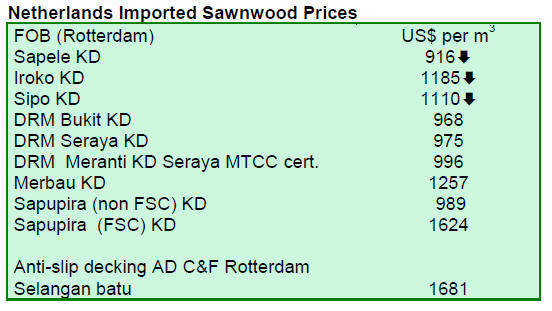
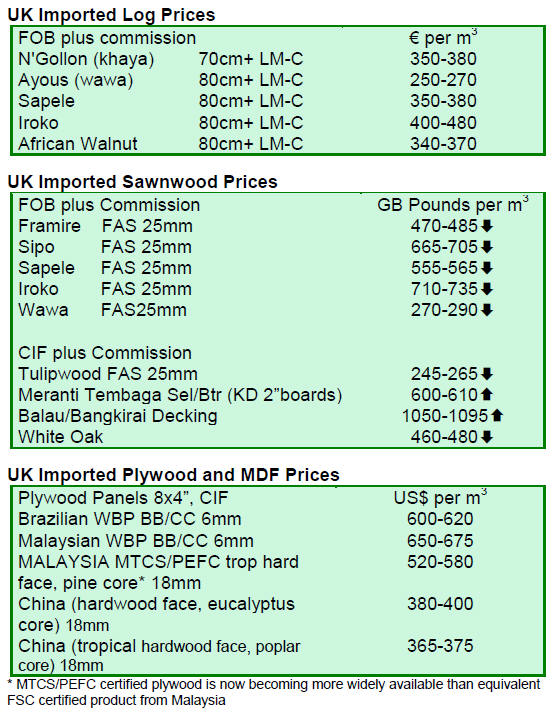 Related News:
|